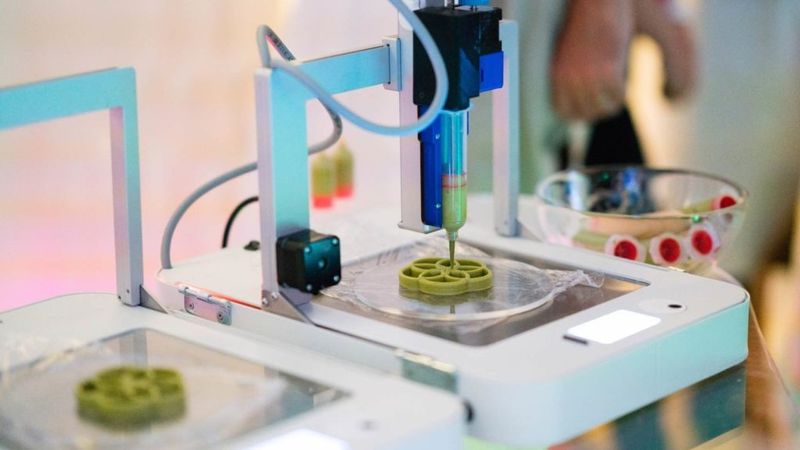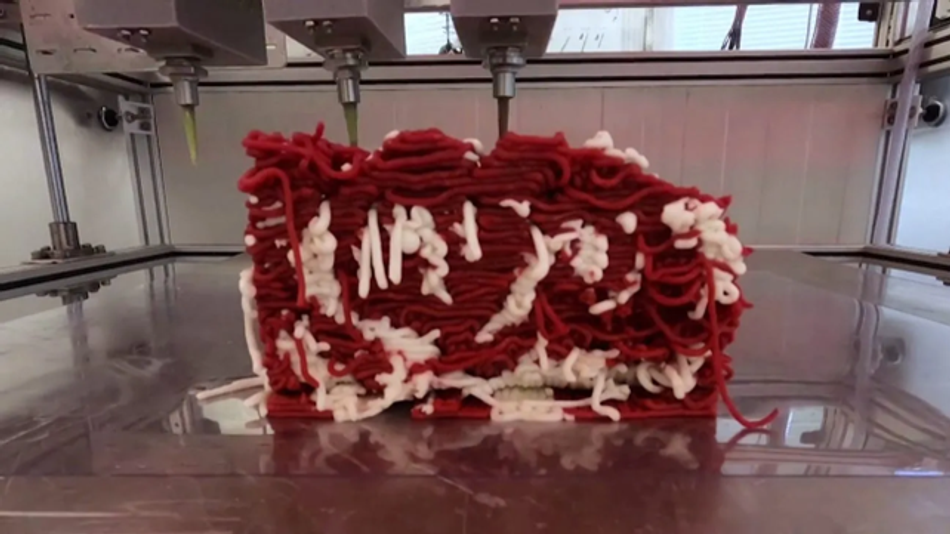You Want Me to Eat What? The Rise of 3D Printed Food
3D printed food might have started as a novelty, but this niche area of additive manufacturing is giving producers and consumers food for thought.
You’ll find a few appliances on a typical kitchen counter. A toaster? Almost definitely. A stand mixer? If there’s a baker in the house. An air fryer? More and more frequently — and not just among food hipsters. What you’re less likely to find between the range and the spice rack is a 3D printer.
And yet 3D printed food is steadily becoming a real phenomenon. While we’re unlikely to ever print an entire hot meal from a single machine, and while some current examples of food 3D printing might sound a little silly, the technology behind culinary 3D printing is no mere gimmick. Many foods are highly suited to common 3D printing processes like extrusion and sintering, and printing food can have genuine advantages, from environmental benefits to the elevated presentation required by master chefs.
This article attempts to show that 3D printed food is not a pie in the sky concept. It’s useful, versatile, and only just getting started.
The Technologies Behind 3D Printed Food
One reason why 3D printing can seem confusing to ordinary people is that “3D printing” can be used to describe some very different technologies. A $200 machine that prints plastic toys operates in a very different way to a million-dollar machine that prints titanium aircraft components or hip implants.
3D printed food is no different — or rather, it’s similarly different. While most food printing applications involve a form of extrusion 3D printing, there are actually several different additive technologies used in food production.
Extrusion
Most consumer-level 3D printers use a technology called fused filament fabrication (FFF) to make plastic objects. This technology extrudes molten thermoplastic filament to build 3D objects one layer at a time.
While you can’t eat thermoplastics, you can use an FFF printer (or a machine resembling one) to extrude and print certain types of food. Some foods behave in a similar way to thermoplastics: chocolate, for example, is solid at room temperature but can be melted and then re-solidified, which has led many cases of 3D printed chocolate, some — like the Fab@Home multi-material printer — dating back almost two decades. But melting and re-solidifying isn’t a necessity when it comes to food. For example, soft materials like frosting and mashed potato can be extruded without a change in temperature.
Extrusion is the dominant food printing technology for several reasons. For one, it is a simple and affordable form of 3D printing. Secondly, food extrusion has already existed for centuries in the form of sausages, certain types of pasta, pastry piping, and beyond. 3D printing simply adds an element of computer numerical control to the process.
Bioprinting
If extrusion represents the simple, affordable, and user-friendly side of food 3D printing, then 3D bioprinting — a cutting-edge form of tissue engineering — is the other extreme. Experts hope that bioprinting will one day allow us to print transplantable human organs and save millions of lives. But it can also be used to make steak.
Since 2013, when startup Modern Meadow demonstrated the printing of meat and leather, scientists have been coming up with news ways to bioprint cultured meat. 3D bioprinters deposit liquids called bio-inks, which contain cells and a matrix material, onto a scaffold (as the bioink is not typically self-supporting). The printed structure is then typically placed in a bioreactor to encourage tissue growth.
Though extremely complex, 3D bioprinting has been shown as a viable means of forming lab-grown meat, which has significant environmental advantages over livestock farming.
Powder
Two less common varieties of food 3D printing technology are selective laser sintering (SLS) and binder jetting. While these two processes work in different ways — SLS uses a laser to fuse particles together, while binder jetting uses a liquid binder — both can be used to print foods in powder form. Powdered foods suitable for 3D printing include sugar, chocolate powder, and specially formulated protein mixtures.
Applications of Food 3D Printing (and Why They are Helpful)
The uses of food 3D printing range from the entertaining to the potentially world-changing. Here we look at some of the more widespread uses of 3D printing technology in food production.
Confectionery
Some of the earliest examples of food 3D printing have involved chocolate and candy. This is partly down to the extrudability of chocolate and partly down to the obvious mass appeal of 3D printed sweet treats with unusual or customizable geometries. Candy giant Hershey’s saw the potential here, teaming up with additive leader 3D Systems in 2014 to launch the “CocoJet” chocolate 3D printer.
Baking
One of the simplest forms of traditional food extrusion is piping — squeezing a paste-like substance from a bag through a shaped nozzle. Some companies have used machines resembling FFF 3D printers to automate the piping process, allowing for fast and accurate 3D deposition of frosting and other materials. One company operating in this space is BeeHex, which sells machines for small and large-scale cake decoration.
Fine dining
Avant-garde chefs love to experiment with technology, and 3D printing has unsurprisingly found a niche in certain fine dining circles. In late 2020, Michelin-starred Restaurant Cocina Hermanos Torres in Barcelona came up with several elaborate dishes using the Foodini 3D printer from Natural Machines, which uses a syringe-style extrusion mechanism that can be filled with foods of the user’s choice.
Space food
One of the more experimental strains of food 3D printing is the development of nutrient-rich powdered food that can be printed by astronauts in outer space. While this area of food 3D printing research will have as many cynics as it has champions, NASA is taking the idea somewhat seriously, having offered grants to companies researching the topic.
Cultured meat
While still in its infancy, 3D bioprinted meat is one of the most exciting areas of food 3D printing. Lab-grown meat is more environmentally friendly than livestock farming, with the added benefit of not actually harming animals. On the other hand, this may be the area of food 3D printing that invites the greatest level of skepticism: many will balk at the idea of eating a hamburger grown in a petri dish.
3D Printed Food Case Studies
We have so far looked at the key technologies and some of the common applications of food 3D printing. Here we take a closer look at two organizations that have used 3D printing in a particularly interesting way.
Barilla’s 3D printed pasta
Italian food giant Barilla, the world’s largest producer of pasta, has witnessed several technological innovations since its founding in 1877. In 2015, the company introduced 3D printed pasta to the world, working with Dutch research firm TNO to develop a printer that could process dough. While most 3D printer users give up and start again when their prints look like spaghetti, Barilla encouraged it, asking members of the public to come up with 3D printable pasta shapes.
Of course, 2015 was the heyday for novelty 3D printing stories, so 3D printed pasta was sure to cause a stir. But Barilla continues to sell 3D printed pasta shapes to this day, proving that its extruded creations were more than just a flash in the pan. Its BluRhapsody division sells a number of unique 3D printed pasta varieties, including an egg shape, a bunny shape, and “spaghetto 3D,” targeting these premium products at upscale restaurateurs.
3D printed pasta shapes have practical as well as aesthetic benefits. For example, several of the complex geometric designs are hollow, allowing them to be filled with meats, cheeses, sauces, or other fillings.
Osaka University’s 3D printed Wagyu beef steak
When people picture lab-grown meat, they probably picture the very opposite of Wagyu beef, one of the most expensive meats in the world thanks to its tender fatty structure and delicious flavor. However, in 2021 scientists at Osaka University used 3D bioprinting to recreate the famous Japanese export.
In vitro meat was first bioprinted way back in 2013, and several research groups and companies have since attempted to perfect the process. The printed Wagyu was a particularly complex endeavor, however, due to the distinctive marbling or sashi of this type of meat. To recreate this pattern, the scientists used a combination of muscle fibers, fat, and blood vessels, printing the three distinct components in layers to mimic the organic beef.
“By improving this technology, it will be possible to not only reproduce complex meat structures, such as the beautiful sashi of Wagyu beef, but to also make subtle adjustments to the fat and muscle components,” explained study co-author Michiya Matsusaki.
The Future of 3D Printed Food
To become a mainstream culinary technology, 3D printing still has to overcome a few hurdles. For starters, providers of food printers need to identify challenges where 3D printing can offer a genuine solution — not be just a gimmick. The novelty era of 3D printing has been and gone. Consumers will now only entertain 3D printed food if it tastes good, looks good, and has a reason to exist.
In areas like 3D bioprinting, another challenge is convincing consumers — many of whom have been brought up believing that organic is best — that a lab-grown meat is sensible, tasty, and not the Frankenstein’s Monster of proteins.
In all likelihood, your kitchen counter probably won’t have a 3D printer sitting on it in 10 years’ time. But your pantry might just contain some 3D printed pasta and your fridge some bioprinted meat.


